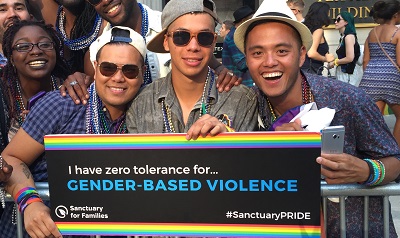Sanctuary for Families Development Intern, Adaiya Grandberry, reflects on her time at Sanctuary as she prepares to head back to school.
My first college internship
Two months – more like two weeks. It’s setting in that my time at Sanctuary for Families has come to an end and I’m not sure how I feel about it.
As my first internship coming out of my freshman year of college, and one that was at a leading service providing nonprofit no less, I wasn’t exactly sure what to expect. My immediate reaction upon arriving on my first day was ‘wow’.
‘Wow’, not only at my work, but ‘wow’ at the work Sanctuary for Families does as a whole — at the dedication of Sanctuary’s staff and at the way that the departments come together to make it all happen. From social work to legal representation to volunteer coordination to event planning (the list goes on), it amazed me how many programs function within Sanctuary for Families and how well-established each program is — all in the context of a nonprofit.
Sanctuary for Families challenged my perception of nonprofits
What do you think of when you think of a nonprofit?
Well, I imagined a small organization, with few staff. I imagined a small group of people, all focused on one central program. I imagined that small group of people, all more concerned with figuring out how they’ll make it to the next fiscal year rather than the needs of the clients they serve. I was wrong.
Sanctuary for Families is a nonprofit that has sustained itself. Money doesn’t come easy in the nonprofit world, but Sanctuary manages to dedicate 85 cents of every dollar raised towards its programs and to its community.
During my time at Sanctuary, I worked closely with the Institutional Giving and Communications teams. In learning about the grant-writing process, I gained greater insight into all the programs that really distinguish Sanctuary from other service providing organizations. As I began writing grant proposals myself, I began to better understand what Sanctuary is really about.
What Sanctuary for Families is really about
Sanctuary for Families creates a ‘sanctuary’ for clients by offering safe spaces to people from all backgrounds, races, sexual identities, abilities and religions. Sanctuary is about developing change-makers and empowering individuals in the community to determine their own lives. Sanctuary provides the tools, the people and the support system for clients to overcome whatever gender violence they’ve experienced.
Although much of what I’ve learned about is difficult to take in, it is also critical for me to understand. This experience will push me to question and evaluate how institutions claim to “serve” and create “social impact” in their communities. It has also pushed me to re-evaluate my life and goals.
What does this mean for my career and the path I choose? I have no idea.
But one thing that I am sure of is this: Sanctuary is genuinely and completely committed to its community and to its mission.
And I am so incredibly thankful for that.



